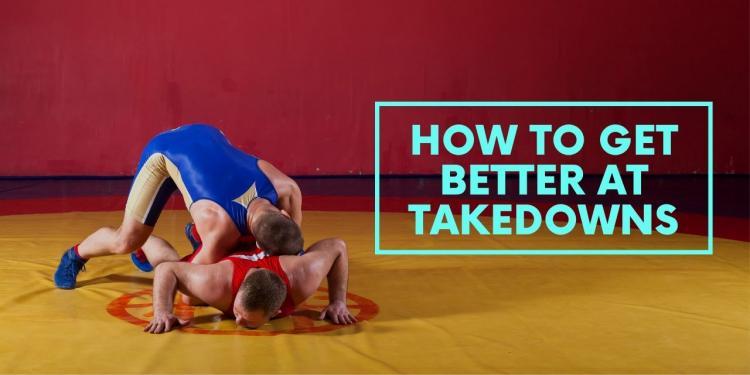The ability to take someone down is an essential aspect of many combat sports. This skill is also important for defending yourself in a street fight. A successful takedown or throw will weaken your opponent and leave them in a vulnerable position for you to capitalize on. This article combines training exercises and concepts from various grappling styles to provide a guideline for getting better at takedowns.
Drillers Make Killers
Drilling is the process of repeating a technique or movement over and over again so that it becomes muscle memory, sharpens the specific technique and develops your skills. The list below describes an assortment of technique drilling examples to get you better at takedowns.
Solo Grappling Drills
Technical movements that you could perform by yourself.
- Footwork – Get into the proper stance for whatever grappling style you prefer (wrestling, greco roman, judo, etc.). Move in different directions while maintaining your stance. Be mindful of your posture and form. Add movements like pivoting and circling to this drill as well.
- Movement Drills – Practice setups and takedown movements utilized in your respective martial arts. Examples for wrestling below:
- Changing level and following up with a penetration step
- Wrestling duck walk
- Arm drag to back control
- Sprawling, moving back to a wrestling stance and then immediately shooting for a double leg
- Techniques – Drill techniques you struggled to pull off in sparring. Focus on doing the technique in a slow controlled manner to enhance your body’s coordination for performing it, then gradually execute the technique at a faster speed.
- Shadow Grappling – Similar to shadow boxing, this exercise requires you to replicate sparring scenarios with an imaginary opponent. Be creative and move at the speed that you will actually encounter in a match. Doing this will help you accustom yourself mentally and physically to actual competition conditions.
Partner Grappling Drills
Having a good training partner is important for maximizing the benefits received from partner drills. Unlike the previously mentioned solo drills, drilling techniques with a partner allows you to practice lifting, balancing and completing throwing motions with actual resistance. Additionally, using teammates with various weight, shape and size is great for learning how to adjust and adapt your body position appropriately to take down anybody.
- Leg Placement – Move around with your training partner and have them randomly switch stances. Carry out a takedown technique according to their leg placement. For example, judo practitioners should work on inside and outside leg trips based on the partner’s relative stance to their own. While a wrestler trains shooting for a single leg or a double leg depending on whether the teammate’s lead leg is the same side as their lead leg or not. This insures that you are able to land your takedowns from anywhere.
- Countering Sprawls – Get your teammate to sprawl each time you shoot for a takedown attempt. Incorporate techniques that counter this action or work on scrambling back to your feet.
- Balancing Your Teammate – To master the ability to do throws, focus on completing the technique by using leverage instead of strength. For example, a drill for improving your hip toss technique is the repetition of loading a larger teammate onto your hip and balancing them with your body frame so that they feel “weightless.”
- Grip Fighting – If you cannot remove an opponent’s grips or separate from their clinches, then the opponent could control where the actions occurs. Consequently, it is critical for you to practice peeling off grips, such as gi (uniform) collar grips or a wrestling collar tie.
- Snap Down – Break down your opponent’s posture with the snap down technique that uses the wrestling collar tie grip. A person’s common reaction is to regain their composure by immediately posturing back up. Anticipating this reaction allows you to time your level change and penetrate inside for a takedown. Practice using the snap down to set up various takedown techniques.
Takedown Concepts and Strategies
Each grappling style has their own fundamental concept that makes them effective. The content below details key concepts and strategies for improving your takedown skills.

- Takedown Roadmap – It is valuable to have the ability to chain takedown sequences together and blend them with different clinching setups. Therefore, you should create a road map that dictates what takedown techniques can pair up with each other, what works with a particular clinching position and what you can do based on the opponent’s reaction. This will create a foundation on how to proceed from any setup or takedown.
- Off-Balance – To maximize your success in moves like Judo throws, work on disrupting your opponent’s balance (kazushi in judo) before progressing to any takedown attempt. For example, judo practitioners use their grips to perform movements that off-balances and bring their opponents to the edge of their tippy toes before following up with a hip or shoulder throw.
- Changing Levels – For takedown techniques that require you to shoot forward with a penetration step, consistency in changing your levels is vital.
- Fighting for Head Position – Make it a habit to use your forehead as a tool to manipulate the opponent’s head position. This action will impede their vision and off-balance them. The head actually acts as a 5th limb when grappling. Good grapplers use their head to push against their opponent.
- Stopping an Opponent from Posting – People frequently use their arms as a measuring tool to determine if they are within range to shoot for a takedown. They will also post their hands on your body to impede your forward movement. Take advantage of this situation by implementing arm drags or simply pushing their arms upward and exposing their lower body for a double leg.
- Grab and Go – Due to a bigger opponent’s superiority in size and strength, concentrate on utilizing setup moves that lets you quickly grab them, immediately disrupt their balance or posture, and create openings for takedowns as they try to recover. The movements should occur rapidly, so that the opponent is unable to get a hold of you. If the initial attempt fails, you could always disengage. Arm drags and snap downs are examples of these moves.
- Keep Them Guessing – Spamming the same combinations of moves over and over again makes you predictable and easier to counter. This is where having an extensive takedown roadmap comes in handy. Constantly changing your positional setups and takedown combinations will effectively keep them guessing and a step behind you.
- Moving the Opponent into Position – During sparring, move your opponent into positions where you want them. An example of translating this action into a single leg:
- As you engage into a clinching position, slide your hands forward and obtain double bicep control.
- Pull the arm that is on the same side as your lead leg. Use your footwork and move them with your body instead of just using your arm strength.
- To maintain their balance, the opponent will step forward on the side of the pulled arm.
- Now you have their lead leg to match yours, which is perfect for shooting into a single leg.
What Takedowns You Should Concentrate On
The above article provides a basic primer on how to get better at takedowns. Although there are probably over 100 takedowns and various variants of each takedown, the great majority of accomplished grapplers have 3-4 favorite takedowns that they always go during sparring or competition. It should be no different with you. If you are not comfortable with takedowns yet, the four most basic takedowns you should really learn are the single leg, double leg, the high crotch, and the outside leg sweep.
Single Leg Takedown
The single leg is a great takedown for beginners, especially if you are your stance mirrors your opponent (southpaw versus orthodox). A lot of southpaws use this successfully in MMA, such as Demian Maia. Khabib was also notorious for shooting for low single legs during the first part of his MMA career.
If you watch the video below, Demian Maia mainly uses the single leg entry and then may try to switch to something else once he gets a hold of you. But the single leg is what he shoots for first. His opponents know it, but they still can’t stop it.
Double Leg Takedown
The double leg is another basic wrestling takedowns and requires a bit more penetration than a single leg takedown. It also may require you to drive much more than a single leg to land. However, it is a very powerful takedown and your opponent will feel the fall. Here is a basic video tutorial of the double leg:
High Crotch
A high crotch takedown is a cross between the single leg and the double leg. While it doesn’t require as much athleticism as the double leg, it does require a bit more technical aptitude than a single leg. Like a single leg, you are shooting for the lead leg. But unlike the single leg, you have your head outside of your opponent instead of inside. Here a good video tutorial of the high crotch:
The single, double, and high crotch are all high percentage takedowns that you can switch back and forth from. Drill them and try to execute them during sparring. Shooting for takedowns is very uncomfortable if you do not come from a wrestling background but it gets easier the more you do it.
Outside Leg Sweep/Trip (Gi and No Gi)
The forth takedown, the outside leg sweep, is probably the easiest take down to try out of the four as it does require you to shoot. This was one of the first takedowns I landed successfully when first doing judo. It’s fairly easy to land against new people who don’t have a good sense of balance. In judo, this is called the deashi harai. Here is a video demonstration below:
In no-gi, this trip is my favorite takedown to land. It is an extremely high percentage takedown with BJJ guys as they love to tie up. Once in a tie-up, I try to get double-unders or a body lock and then land the trip. Here is a variation of the trip without a gi and from a body lock:
The judo version with the gi is more like a sweep and the no-gi version of this takedown that I like to do is more like a trip. So what’s the difference? Both rely on off-balancing your opponent. However, with a sweep, you are depending on the motion of your own leg in order to land the takedown. With a trip, you are relying on the opponent tripping over your leg. But with both, you are trying to push your opponent’s balance to their side, and not backwards.




